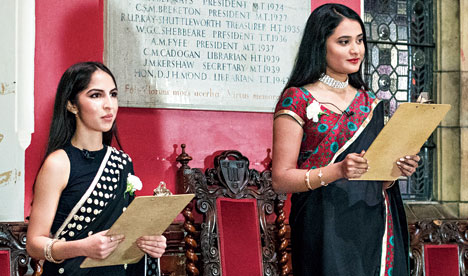The poignancy that memoirs of pre-Partition Punjab evoke is perhaps not found with the same intensity elsewhere in South Asia. There is a large corpus of such Punjab memoirs and in many it is the lost cosmopolitanism and high culture of Lahore that most stands out. Yet in the genre there are two that are striking for the lost world they conjure up; not so much Lahore — but other towns of Punjab for which the uninformed outsider today would generally reserve the term, ‘nondescript’.
The two authors were, and still are, well-known public figures in India and Pakistan. Prakash Tandon (1911-2004) published the first volume of his memoirs, Punjabi Century, in 1961. He was then the chairman of Hindustan Lever — incidentally the first Indian to head a multinational organisation in India. His role in the ‘Indianising’ a foreign company, and a major multinational one at that, marked him out in the Indian corporate universe as someone exceptional. Thereafter, his role in the public sector, as chairman of Punjab National Bank, the State Trading Corporation — of great importance during the licence-permit raj days — and then the Indian Institute of Management, Ahmedabad located him in the 1970s and 1980s at the centre of the pantheon of Indian management gurus. It is, however, his autobiographical volumes — Punjabi Century to be followed by Beyond Punjab (1971) and Return to Punjab (1980) — that introduced him to a larger reading public and made his personal life story one that many related to and saw as a part of a wider Indian saga.
Notwithstanding its wider context and appeal, the core of the books devolved around West Punjab’s history and identity. Prakash Tandon’s early life had all the milestones of the educated middle class, including extended sojourns in Lahore and study in its famed Government College. Yet it is not Lahore for which Tandon saved his most evocative and moving pages but rather the ancestral West Punjab towns of Jhelum and Gujrat. On both these Tandon bestowed special characteristics, such as possessing a “self-contained medieval unity of life”. In his account, their hereditary, diverse crafts, occupations and jostling religious denominations all coexisted in the congested spaces of these ancient towns. He was to describe his familial history in a manner that tied him to a West Punjab countryside: “For two centuries we had been moving along the banks of the Jhelum river, sometimes on its eastern and sometimes on its western bank...”
If the Jhelum river and Gujrat and Jhelum towns defined much of Tandon’s Punjab memory we have also the case of possibly Pakistan’s best-known historian, K.K. Aziz. Beas and the town of Batala in East Punjab comprise in his account a similar moral universe. The Beas was “our ancestral river on both banks of which our family had lived for the last 300 years of more”. To Aziz, seeing it was “the flux of history” and “witnessing history” for “it was the very same river which my ancestors had seen and lived with”.
Aziz (1927-2009) is known for his many books on Pakistan’s modern history. Best known among these is the classic, The Murder of History (1985), which is a critique of textbooks and history teaching in Pakistan. His career in Pakistan was a chequered one as his abilities as a fiercely independent historian meant often being in the adverse notice of the powers that be. Consequently, many years were spent abroad, often in exile. Much of what he wrote remains in print with the significant exception of a work on the breakup of Pakistan in 1971, which has remained unpublished although a full manuscript does exist. The study was commissioned by Zulfikar Ali Bhutto as a post-mortem of policies that led to the events of 1971. It never was published as Bhutto himself was toppled in a coup when the book reached completion. In Aziz’s autobiography there is, of course, a great deal about Lahore, its history, culture and politics and, as with Prakash Tandon, the world of the Government College figures prominently. Nevertheless, in the two volumes of his autobiography, it is Batala that is most evoked as a self- contained intellectual, cultural and spiritual centre.
Aziz’s treatment of a remembered Batala is painstakingly minute — its history, spiritual and intellectual life, his family connections, the layout of its streets, the architecture of its havelis and so on. Much of this was written from memory and with the passage of time Batala acquired an additional glow. It was, in Aziz’s words, a town that “had not been deprived of its wrinkles and individualities. It had a taste of Islam to it, a flicker of Hinduism and a small but potent validation of Sikhism permeated its life. A tiny but burgeoning Christian community flavoured the air”. Aziz was also to term his attachment to Batala “obsessive”, considering that he had lived there only for a few years before moving to Lahore. Yet it was also “the Garden of Eden” and he was to write: “On several nights for the last 59 years I have walked streets, tracked the route from my school to my house, run in the school ground, visited my relatives’ houses, followed all the bazaars one by one to their end; lived in Batala.”
Partition meant the loss of these childhood homes for both Tandon and Aziz. Jhelum and Gujrat went to Pakistan, Batala to India. Possibly the suddenness of the event accompanied by the enormous violence of the actual displacement imparts to these memoirs that added burden of loss and marks the distinction from the traditional nostalgia for the past that normally exists in many memoirs.
Is there a difference with the memories of the other great Partition — in Bengal? Perhaps because the intensity of violence was less in the east and the imminence of the threat less immediate, there is a difference. Migration, in significant enough numbers, did take place in Bengal but was spread over several decades, unlike in Punjab where the entire drama was compressed into a few apocalyptic months. Finally, the displacement in the west was of a qualitatively different nature, with its two halves both undergoing a virtually complete ethnic cleansing. Prakash Tandon was to write: “Today we have no one left in Gujrat. All the Hindus came away at partition. It is strange to think that in all the land between Ravi and Chenab, from Chenab to Jhelum, from Jhelum to Indus... land which had been the homes of our biradaris since the dawn of history, there is no one left of our kind.” In a similar way Aziz was to say, “A thousand year history was overturned” and “an iron curtain fell between Batala and me”.
Thus, if comparisons have to be made, Aziz and Tandon would have to be compared with Jewish memoir writers of pre-war Europe or the Sudeten Germans of Czechoslovakia or those in Poland and Hungary who were expelled in their millions to a Germany cut down in size after World War II.
In spite of these larger considerations, the enduring quality to Prakash and Aziz’s memoirs come from the small but jewel-like towns they remember and bestow with such exceptional intellectual and cultural qualities. For those of us used to the metropolis and the large city, carrying an unmistakable condescension towards the small town, their evocation is a reminder that these, too, have been important sites of our history and intellectual life.
The author is a retired diplomat and currently Director General of the Indian Council of World Affairs













